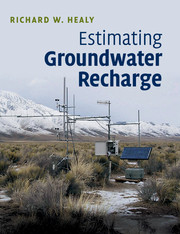Book contents
- Frontmatter
- Contents
- Preface
- Acknowledgments
- 1 Groundwater recharge
- 2 Water-budget methods
- 3 Modeling methods
- 4 Methods based on surface-water data
- 5 Physical methods: unsaturated zone
- 6 Physical methods: saturated zone
- 7 Chemical tracer methods
- 8 Heat tracer methods
- 9 Linking estimation methods to conceptual models of groundwater recharge
- References
- Index
6 - Physical methods: saturated zone
Published online by Cambridge University Press: 05 April 2013
- Frontmatter
- Contents
- Preface
- Acknowledgments
- 1 Groundwater recharge
- 2 Water-budget methods
- 3 Modeling methods
- 4 Methods based on surface-water data
- 5 Physical methods: unsaturated zone
- 6 Physical methods: saturated zone
- 7 Chemical tracer methods
- 8 Heat tracer methods
- 9 Linking estimation methods to conceptual models of groundwater recharge
- References
- Index
Summary
Introduction
Among the most widely used techniques for estimating recharge are those based on measurement of groundwater levels over time and space. The abundance of available groundwater-level data and the simplicity of these methods facilitate straightforward application. The water-table fluctuation method uses fluctuations in groundwater levels over time to estimate recharge for unconfined aquifers; it is the focus of most of this chapter. Included in the discussion of the method are an analysis of mechanisms that can cause water-table fluctuations and a review of methods for estimating specific yield. Other methods addressed in this chapter are based on the Darcy equation and include an approach developed by Theis (1937), the Hantush (1956) method for estimating interaquifer flow, and the application of flow nets. The chapter also includes a discussion of approaches based on time-series analyses of measured groundwater levels. The content of this chapter draws from and expands upon the material presented in Healy and Cook (2002).
Groundwater-level data
Many local, state, and federal agencies maintain databases of measured groundwater levels in individual countries. Within the United States, the US Geological Survey maintains the largest database on real-time and historic groundwater levels (Table 2.1). Groundwater levels can be measured manually by using a graduated measurement tape to determine the depth to water in a well from a reference point at the top of the well casing. Historically, groundwater levels in some observation wells were automatically recorded by using a float that was attached by a steel tape or wire to a wheel sensor; a strip-chart or paper-punch device was used to record movement of the wheel (Rasmussen and Andreasen, 1959). Submersible pressure transducers have come into widespread use for monitoring groundwater levels since the 1990s (Freeman et al., 2004). These electronic devices can automatically sense and record groundwater levels at user-selected frequencies. The depth (relative to the reference point on the well casing) at which a transducer is placed in a well must be carefully measured. If groundwater elevation is desired, the elevation of the reference point needs to be determined.
- Type
- Chapter
- Information
- Estimating Groundwater Recharge , pp. 117 - 135Publisher: Cambridge University PressPrint publication year: 2010



